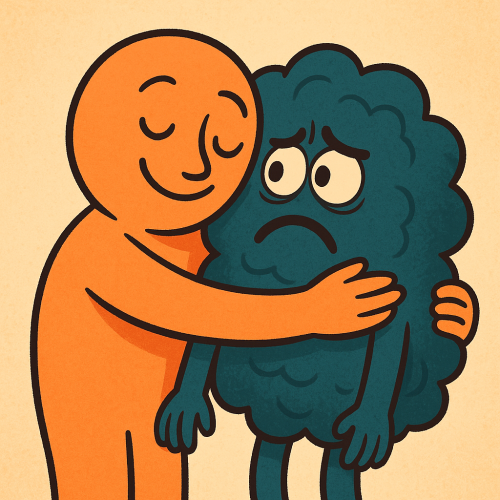 In this article we’ll look at what the experience of anxiety is like in our minds and our bodies, the impact it can have on our lives, and what a healthy way of dealing with it looks like.
In this article we’ll look at what the experience of anxiety is like in our minds and our bodies, the impact it can have on our lives, and what a healthy way of dealing with it looks like.
We’ll explore how we can see it not as our enemy, but as our friend.
---
Anxiety is not who you are
One of the most powerful shifts we can make is to stop labelling ourselves as an anxious person. It’s much more accurate to say, “I experience anxiety.” No one is anxious all the time. Even those who struggle the most have moments of calm.
If we define ourselves as anxious, it feels permanent, like we’re stuck that way. But the reality is, how we feel is changing all the time and overtime we can become less anxious.
I’ve seen how, with mindfulness training and support, you can learn how to feel calmer by embracing anxiety, and that transforms your life.
---
What does anxiety feel like?
At its core, anxiety is about not feeling safe. Rationally, we may know there’s no tiger about to bite our head off, but the mind and body reacts as if there were. Maybe our heart-rate elevates, our breathing might become shallower.
Some people experience sleeplessness, restlessness, fidgeting, or tension in the belly, chest, shoulders, or face.
Anxiety can isolate us, hold us back from the relationships we want, the work we want, or even just stepping out of the house.
For most of us it’s not about physical safety, it’s more social. We fear rejection, not belonging or disapproval.
It can feel like impending doom—like in Game of Thrones when they keep saying, “Winter is coming.” You know something terrible is around the corner, even if it never actually arrives.
---
Anxiety as our friend
So given all of that, why on earth would we want to embrace anxiety?
Because anxiety is trying to help us. It’s trying to keep us safe, to protect us from pain, rejection, or harm. It’s not our enemy, it’s our friend. The problem is that it can get too noisy, like an overzealous guard dog barking at everything that moves.
Mindfulness gives us a way of soothing that overactive system. Instead of saying, “Go away, stop ruining my life”, we can meet anxiety like we would a scared child: “It’s okay. You’re safe. I’m here. I’ve got you.”
---
A meditation for anxiety
Here’s a meditation you can try. Choose a real situation in your life that brings some anxiety. Not a 10/10 panic situation, but also not something that barely bothers you. Aim for the middle ground.
1. Start with a few deep breaths, in through the nose, out through the mouth. Slow, calming breaths that signal safety to your nervous system.
2. Maybe slowly turn your head to look around the room, seeing there’s no danger. Feel your connection with the chair and the ground beneath you.
3. Bring to mind your chosen situation. Notice where anxiety shows up in your body: do you feel it in your chest, belly, shoulders, jaw? Acknowledge that this is suffering. This is difficult.
4. Remember common humanity: everybody suffers, everybody feels anxious at times. You’re not alone.
5. Place your hands somewhere soothing: your chest, belly, or even give yourself. Imagine sending kindness into your body. Repeat silently:
May I accept my feelings.
May I be kind to myself.
May I be safe.
Stay with this for a few minutes. Notice if anything shifts.
You can listen to a free guided meditation for calming anxiety here.
---
How it can help
Acknowledging our suffering means we’re not dismissing it, and that can already create a softening. Common humanity reminds us there’s nothing wrong with us, and that can be reassuring. A hand on your chest and belly with kind words can be very soothing and calming.
It might sound counterintuitive to connect more to anxiety, but by knowing it more deeply, we stop running away from it. We stop being scared of it. That’s what embracing anxiety really means.
---
Further support
Supporting people with anxiety is my bread and butter. Over the last 12 years, I’ve seen so many people transform from sleepless nights, constant tension, and expecting the worst to feeling calmer, more confident, and back in control of their lives.
If anxiety is holding you back, you don’t have to keep struggling with it alone. Book a free 30-minute call and we’ll explore simple, practical ways to start shifting your relationship with anxiety — so you can feel more ease and confidence in daily life.
This article is part of a series on emotional fitness. Last week was Embracing Anger and next week is Embracing Sadness.